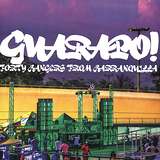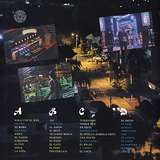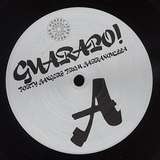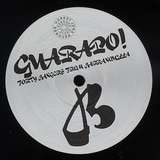Jeanpi Perreo, Edwin Producciones & DJ Ander: Forty Bangers From Barranquilla
Vintage African musics treated in breakbeat mode though chants focused & in Barranquilla and Cartagena style
- 01 Jeanpi Perreo: Kole Con El Wee
- 02 DJ Ander: Isleño
- 03 Edwin Producciones: El Bobo
- 04 DJ Ander: La Gyal
- 05 Jeanpi Perreo: Anda
- 06 Jeanpi Perreo: El Sason
- 07 Edwin Producciones: Carlitos
- 08 Jeanpi Perreo: El Feo
- 09 Edwin Producciones: Agua
- 10 Jeanpi Perreo: La Niña
- 11 Jeanpi Perreo: Ah!
- 12 DJ Ander: Curaçao
- 13 Edwin Producciones: El Adios
- 14 Edwin Producciones: El Bety
- 15 Edwin Producciones: Te Llego Mon?#
- 16 Jeanpi Perreo: Marisol
- 17 Edwin Producciones: El Ñato
- 18 Jeanpi Perreo: El Gato
- 19 Jeanpi Perreo: El Papy
- 20 Jeanpi Perreo: Psicodelico
- 21 Jeanpi Perreo: Turbiando
- 22 Edwin Producciones: Vasile 2016
- 23 Edwin Producciones: En Seco
- 24 DJ Ander: Sacale Dios
- 25 Edwin Producciones: El Pitillo (Harold Edit)
- 26 Jeanpi Perreo: Una Noche
- 27 DJ Ander: El Italiano
- 28 Jeanpi Perreo: El Reloj
- 29 DJ Ander: Y Como?
- 30 Edwin Producciones: El Loco
- 31 Edwin Producciones: El Deito
- 32 DJ Ander: El Pase
- 33 DJ Ander: Quidao
- 34 DJ Ander: Apretaito
- 35 DJ Ander: Voz
- 36 DJ Ander: Tu Fuiste
- 37 DJ Ander: Pa Caite
- 38 DJ Ander: La Pantera
- 39 DJ Ander: Mamon
- 40 DJ Ander: Doble Diablo
‘Sound system culture in the Colombian cities of Barranquilla and Cartagena stretches back to the 1950s. It began on a small scale, with the sounds being little more than the basic equipment that neighbourhood backyard dance parties needed to play the popular music of the day. The favoured styles were chiefly drawn from the musica costeña – the popular dance music of the Colombia’s Caribbean coast, such as cumbia and porro – and the ubiquitous sounds of Cuban mambo, rumba and son, whose influence had been powerfully felt across the Caribbean basin. During the 1960s, the sound systems or picós – the derivation of the word is obscure, but is thought to come from ‘pick-up’, perhaps a reference to the turntable needle – became more elaborate and more widely established. Employed to build the sounds from scratch, often from reconditioned and recycled gear, local technicians began to ramp up the volume and power. The taste of the selectors also began to include music from further afield, in particular New York salsa, which enterprising sailors had started to bring in to the coast from the US and sell directly to the picós, whose operators were eager for exclusives and fresh sounds. By the end of the decade, the main particulars of the cultura picótera were in place, and popular picós would travel to play dances, known as verbenas, around Cartegena, Barranquilla, and nearby towns and cities.
Popular African music was not distributed in Colombia during the post-war period, for the simple reason that there were no immigrant African communities to demand it, and no audience or market for it among Colombians. But as the fashion for salsa began to wane in the early 1970s, the picó operators began to look for a new style. As with many such organic popular developments, there is little concrete information on how the first African records began to appear within the picóteros’ selections – but the consensus seems to be that, as with salsa, they had been first brought in by sailors. The astute picó operators quickly recognised both the potential popularity of the sound, and saw a new way to sonically distinguish their picó from the competition. It is probable that there had been some African music brought in the late 1960s, and also some importation of Haitian records, but one thing is for certain – by the mid-1970s, a picó’s reputation stood or fell on the selection of African music it could bring to the dance.
In response to this highly specialised demand, the importation of African music became systematic, though it remained underground and there was still no general distribution of African recordings. Obtaining the latest and most exclusive African discs had become a matter of huge competition between picós in Cartagena and Barranquilla, and the importers, who typically sold records direct to the picós, could command high sums for their latest discoveries. Picó operators went to great lengths to keep their discoveries and rare cuts exclusive, covering up names, painting over labels and swapping album covers in order to shroud their battle weapons in secrecy. The bigger systems even had buyers outside the country, known as corresponsales, to obtain exclusive and unknown cuts, and the picós jealously guarded their sources. A fair amount of non-Spanish Caribbean music was also mixed in with the African music, and this new dominant sound in the verbenas bore the generic name música africana, with favoured genres including highlife, juju, soukous, mbaqanga, and benga.
No culture is static. And whilst turbos and picós still play classic música africana with pride, the new sound of southern Barranquilla is a combination of militant breaks and austere loops known as guarapo (after a popular Colombian drink made of sugarcane and lime).
As with the drum breaks favoured by hip-hop DJs, selectors on the picós often play only certain sections of a favoured record. But guarapo producers go further, looping small sections of vocal or guitar and overlaying thumping percussive beats. Each cut is short, little more than a stark and hypnotic drop for the right moment, to be liberally sprayed with a hail of placas. Samples are typically lifted from African music – highlife, soukous and benga tracks are the usual sources. Our own forty commissions raid Nigerian recordings from the 1960s – kicking off by turns with Sagbeni Aragbada, Olalekan Olorode, Steven Amechi, Eagle Minister’s Dance Band and Cardinal Rex Jim Lawson.
The cuts are rough-hewn and usually intended for just one night’s use – one-away distillations of Barranquilla’s sonic taste as the youth evolve their own iteration of cultura picótera. Most picós still play a mixture of music, and include guarapo cuts alongside the latest tastes in música africana, champeta and so on. Jeanpi Perreo is with the El Rey Latino sound, which combines guarapo with benga and techno. Edwin Producciones is resident producer for the Caribeño picó, one of the best known sound systems in Barranquilla today, and the first to play only guarapo in their verbenas. DJ Ander plays with El Africano, a popular picó based in the Nueva Colombia barrio.
As they say in the verbenas, Aqui Suena: the sound is here!’
Jeanpi Perreo, Edwin Producciones & DJ Ander: Forty Bangers From Barranquilla
Vintage African musics treated in breakbeat mode though chants focused & in Barranquilla and Cartagena style
‘Sound system culture in the Colombian cities of Barranquilla and Cartagena stretches back to the 1950s. It began on a small scale, with the sounds being little more than the basic equipment that neighbourhood backyard dance parties needed to play the popular music of the day. The favoured styles were chiefly drawn from the musica costeña – the popular dance music of the Colombia’s Caribbean coast, such as cumbia and porro – and the ubiquitous sounds of Cuban mambo, rumba and son, whose influence had been powerfully felt across the Caribbean basin. During the 1960s, the sound systems or picós – the derivation of the word is obscure, but is thought to come from ‘pick-up’, perhaps a reference to the turntable needle – became more elaborate and more widely established. Employed to build the sounds from scratch, often from reconditioned and recycled gear, local technicians began to ramp up the volume and power. The taste of the selectors also began to include music from further afield, in particular New York salsa, which enterprising sailors had started to bring in to the coast from the US and sell directly to the picós, whose operators were eager for exclusives and fresh sounds. By the end of the decade, the main particulars of the cultura picótera were in place, and popular picós would travel to play dances, known as verbenas, around Cartegena, Barranquilla, and nearby towns and cities.
Popular African music was not distributed in Colombia during the post-war period, for the simple reason that there were no immigrant African communities to demand it, and no audience or market for it among Colombians. But as the fashion for salsa began to wane in the early 1970s, the picó operators began to look for a new style. As with many such organic popular developments, there is little concrete information on how the first African records began to appear within the picóteros’ selections – but the consensus seems to be that, as with salsa, they had been first brought in by sailors. The astute picó operators quickly recognised both the potential popularity of the sound, and saw a new way to sonically distinguish their picó from the competition. It is probable that there had been some African music brought in the late 1960s, and also some importation of Haitian records, but one thing is for certain – by the mid-1970s, a picó’s reputation stood or fell on the selection of African music it could bring to the dance.
In response to this highly specialised demand, the importation of African music became systematic, though it remained underground and there was still no general distribution of African recordings. Obtaining the latest and most exclusive African discs had become a matter of huge competition between picós in Cartagena and Barranquilla, and the importers, who typically sold records direct to the picós, could command high sums for their latest discoveries. Picó operators went to great lengths to keep their discoveries and rare cuts exclusive, covering up names, painting over labels and swapping album covers in order to shroud their battle weapons in secrecy. The bigger systems even had buyers outside the country, known as corresponsales, to obtain exclusive and unknown cuts, and the picós jealously guarded their sources. A fair amount of non-Spanish Caribbean music was also mixed in with the African music, and this new dominant sound in the verbenas bore the generic name música africana, with favoured genres including highlife, juju, soukous, mbaqanga, and benga.
No culture is static. And whilst turbos and picós still play classic música africana with pride, the new sound of southern Barranquilla is a combination of militant breaks and austere loops known as guarapo (after a popular Colombian drink made of sugarcane and lime).
As with the drum breaks favoured by hip-hop DJs, selectors on the picós often play only certain sections of a favoured record. But guarapo producers go further, looping small sections of vocal or guitar and overlaying thumping percussive beats. Each cut is short, little more than a stark and hypnotic drop for the right moment, to be liberally sprayed with a hail of placas. Samples are typically lifted from African music – highlife, soukous and benga tracks are the usual sources. Our own forty commissions raid Nigerian recordings from the 1960s – kicking off by turns with Sagbeni Aragbada, Olalekan Olorode, Steven Amechi, Eagle Minister’s Dance Band and Cardinal Rex Jim Lawson.
The cuts are rough-hewn and usually intended for just one night’s use – one-away distillations of Barranquilla’s sonic taste as the youth evolve their own iteration of cultura picótera. Most picós still play a mixture of music, and include guarapo cuts alongside the latest tastes in música africana, champeta and so on. Jeanpi Perreo is with the El Rey Latino sound, which combines guarapo with benga and techno. Edwin Producciones is resident producer for the Caribeño picó, one of the best known sound systems in Barranquilla today, and the first to play only guarapo in their verbenas. DJ Ander plays with El Africano, a popular picó based in the Nueva Colombia barrio.
As they say in the verbenas, Aqui Suena: the sound is here!’




